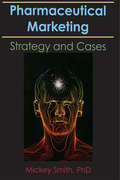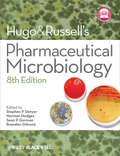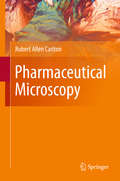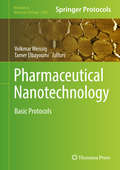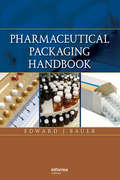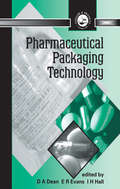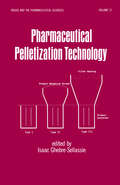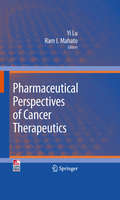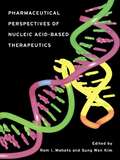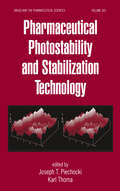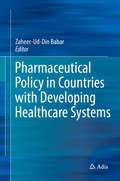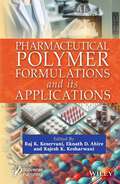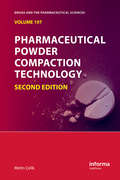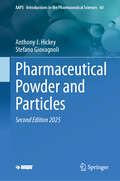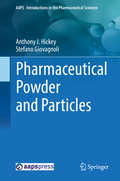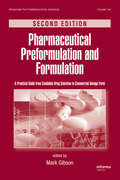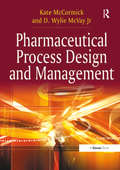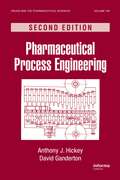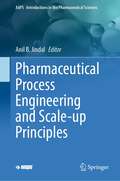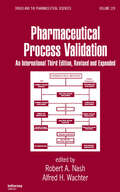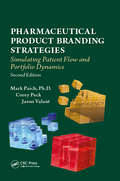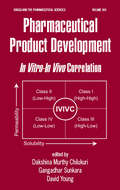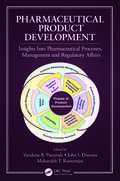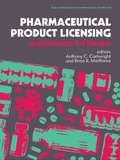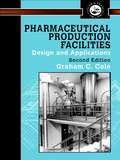- Table View
- List View
Pharmaceutical Marketing: Strategy and Cases
by Mickey C. SmithReflecting the fascinating and dramatic changes in pharmacy, pharmaceutical education, and the pharmaceutical industry in recent years, this authoritative volume focuses on the practice of marketing both prescription and nonprescription medications. In a dozen comprehensive chapters, author Mickey Smith highlights the economic social, and
Pharmaceutical Microbiology
by Stephen P. Denyer B Pharm PhD FRPharmS Norman Hodges B Pharm Sean P. Gorman CBE BSc PhD FPS Brendan F. Gilmore Mrsc MpsPharmaceutical microbiology has a bearing on all aspects of pharmacy, from the manufacture and quality control of pharmaceutical products through to an understanding of the mode of action of antibiotics. Fully revised and restructured, drawing on the contributions of subject experts, and including material relevant to the European curricula in pharmacy, the eighth edition covers: biology of micro-organisms pathogens and host response prescribing therapeutics contamination and infection control pharmaceutical production current trends and new directions Hugo and Russell's Pharmaceutical Microbiology, a standard text for Schools of Pharmacy for seven editions, continues to be a user-friendly and authoritative guide for both students and practitioners of pharmacy and pharmaceutical microbiology. 'Highly Commended' in the Pharmacology section of the 2012 BMA Book Awards
Pharmaceutical Microscopy
by Robert Allen CarltonMicroscopy plays an integral role in the research and development of new medicines. Pharmaceutical Microscopy describes a wide variety of techniques together with numerous practical applications of importance in drug development. The first section presents general methods and applications with an emphasis on the physical science aspects. Techniques covered include optical crystallography, thermal microscopy, scanning electron microscopy, energy dispersive x-ray spectrometry, microspectroscopy (infrared and Raman), and particle size and shape by image analysis. The second section presents applications of these techniques to specific topics of pharmaceutical interest, including studies of polymorphism, particle size and shape analysis, and contaminant identification. Pharmaceutical Microscopy is designed for those scientists who must use these techniques to solve pharmaceutical problems but do not need to become expert microscopists. Consequently, each section has exercises designed to teach the reader how to use and apply the techniques in the book. Although the focus is on pharmaceutical development, workers in other fields such as food science and organic chemistry will also benefit from the discussion of techniques and the exercises. Provides comprehensive coverage of key microscopy techniques used in pharmaceutical development Helps the reader to solve specific problems in pharmaceutical quality assuranceOriented and designed for pharmaceutical scientists who need to use microscopy but are not expert microscopistsIncludes a large number of practical exercises to give the reader hands-on experience with the techniquesWritten by an author with 21 years of experience in the pharmaceutical industry
Pharmaceutical Nanotechnology: Basic Protocols (Methods in Molecular Biology #2000)
by Volkmar Weissig Tamer ElbayoumiThis volume details protocols on formulation, surface modification, characterization, and application of a variety of pharmaceutical nanocarriers such as micelles, nanoparticles, dendrimers, carbon dots, polymersomes, and others. Chapters are targeted toward investigators working in academic and industrial laboratories conducting research in the broad field of pharmaceutical sciences, with an emphasis on drug delivery. Written in the highly successful Methods in Molecular Biology series format, chapters include introductions to their respective topics, lists of the necessary materials and reagents, step-by-step, readily reproducible laboratory protocols, and tips on troubleshooting and avoiding known pitfalls. Authoritative and cutting-edge, Pharmaceutical Nanotechnology: Basic Protocols aims to be a source of inspiration to all investigators who are interested in the potential of the merger of nanotechnology with pharmaceutical sciences.
Pharmaceutical Packaging Handbook
by Edward BauerPharmaceutical Packaging Handbook provides a complete overview of the role that packaging plays in the development and delivery of pharmaceuticals and medical devices. Supplying a thorough examination of the industry in size and scope, the book covers drug dosage forms, vaccines, biologically produced products, and medical foods.Features:Discusses
Pharmaceutical Packaging Technology
by D. A. Dean E. R. Evans I. H. HallPharmaceutical packaging requires a greater knowledge of materials and a greater intensity of testing than most other packed products, not to mention a sound knowledge of pharmaceutical products and an understanding of regulatory requirements. Structured to meet the needs of the global market, this volume provides an assessment of a wide range of i
Pharmaceutical Pelletization Technology
by Isaac Ghebre-SellassieThis book serves as a formulation and processing guide during the development of pelletized dosage forms. It provides the pharmaceutical technologist with basic information about the design aspects of the relevant processing equipment.
Pharmaceutical Perspectives of Cancer Therapeutics
by Yi Lu Ram I. MahatoPharmaceutical Perspectives of Cancer Therapeutics covers a wide variety of therapeutic approaches including gene therapy, immunological therapy; cancer vaccines; strategy for solid tumors as well as for hematological cancers; methods to suppress tumor angiogenesis and metastasis; development and utilization of relevant animal models; introduction of new concepts such as cancer stem cells and new technologies, such as DNA and tissue microarrays; and RNA interference. In addition, clinical application, the development of DNA diagnosis biomarkers and cancer prevention, as well as the utilization of imaging in cancer therapy are also discussed. The use of synthetic carriers, such as lipids, polymers, and peptides for delivery and targeting of small molecules, proteins, and nucleic acids to cancer cells in vivo are discussed. Pharmaceutical Perspectives of Cancer Therapeutics also includes cancer therapy modality in surgery, chemotherapy, and radiotherapy, as well as in combination or multi-modality, giving our book a more focused view of cancer therapy.
Pharmaceutical Perspectives of Nucleic Acid-Based Therapy
by Ram I. Mahato Sung Wan KimEmphasizing its uses in cancer and cardiovascular and autoimmune diseases, Pharmaceutical Perspectives of Nucleic Acid-Based Therapy presents a comprehensive account of gene therapy, from development in the laboratory to clinical applications. Internationally acclaimed scientists discuss the potential use of lipids, peptides and polymers for the in
Pharmaceutical Photostability and Stabilization Technology
by Joseph T. Piechocki Karl ThomaBased on a training course developed by Dr. Joseph T. Piechocki and other experts in this field whose contributions appear in this book for two International Meetings on the Photostability of Drugs and Drug Products, this text clarifies the guidelines set by the International Conference on Harmonization (ICH) and provides a comprehensive background
Pharmaceutical Policy in Countries with Developing Healthcare Systems
by Zaheer-Ud-Din BabarA comprehensive and granular insight into the challenges of promoting rational medicine, this book serves as an essential resource for health policy makers and researchers interested in national medicines policies. Country-specific chapters have a common format, beginning with an overview of the health system and regulatory and policy environments, before discussing the difficulties in maintaining a medicines supply system, challenges in ensuring access to affordable medicines and issues impacting on rational medicine use. Numerous case studies are also used to highlight key issues and each chapter concludes with country-specific solutions to the issues raised. Written by highly regarded academics, the book includes countries in Africa, Asia, Europe, the Middle East and South America.
Pharmaceutical Polymer Formulations and its Applications
by Raj K. Keservani Rajesh K. Kesharwani Eknath D. AhireThe book is an essential resource for anyone in the pharmaceutical field, as it provides in-depth insights into the versatile roles of polymers in controlled drug delivery, highlighting their critical applications in product innovation, development, and manufacturing. Pharmaceutical Polymer Formulations and Its Applications provides an overview of the applications of pharmaceutical polymers in the vast field of controlled drug delivery. Polymers have the potential for a range of uses in the design of pharmaceutical dosage forms. They can be used as suspending, emulsifying, binding, or flocculant agents, as well as adhesives and packaging and coating materials. They can be used to make gels, nanoparticles, microparticles, and various capsules. Polymers have played an indispensable role in the manufacture of pharmaceutical products. This volume includes various polymers used in pharmacy based on their applications. The overviews focus on the use of pharmaceutical polymers for controlled drug delivery applications. Examples of pharmaceutical polymers and the principles of controlled drug delivery are outlined, and applications of polymers for controlled drug delivery are also discussed. Readers will find the book: Explores the latest tactics utilized for the application of polymers in the healthcare industry; Showcases the numerous innovations of polymers in manufacturing of pharmaceuticals; Provides essential elements for the conceptualization and comprehension of polymer products by highlighting their aspects and overcoming manufacturing, regulatory, and quality control obstacles. Audience The book will interest chemists and healthcare professionals interested in pharmaceutical innovation using polymers.
Pharmaceutical Powder Compaction Technology (Drugs and the Pharmaceutical Sciences)
by Metin ÇelikCompaction of powder constituents-both active ingredient and excipients-is examined to ensure consistent and reproducible disintegration and dispersion profiles. Revised to reflect modern pharmaceutical compacting techniques, this second edition of Pharmaceutical Powder Compaction Technology guides pharmaceutical engineers, formulation scientists,
Pharmaceutical Powder and Particles (AAPS Introductions in the Pharmaceutical Sciences #60)
by Anthony J. Hickey Stefano GiovagnoliThis book in the AAPS book series concisely reviews important aspects of powder and particle systems and the critical quality attributes that should be used as a guide to future developments intended to maximize the control of product quality and performance. Hickey and Giovagnoli have written an essential book for any scientists involved in powder or particle research and manufacturing. It is appropriate for those just entering the field or as a rapid reference for the experienced pharmaceutical scientist. The authors have both academic and industrial experience, and the coverage includes solid state chemistry; crystallization; physical processes; particle size and distribution; particle interaction; manufacturing processes; quality by design; and a general discussion of the industry. Pharmaceutical Powder and Particles is intended to concisely review important aspects of powder and particle systems and the critical quality attributes that should be used as a guide to future developments intended to maximize the control of product quality and performance. Innovation in manufacturing has expanded the range of options available for solid dosage form manufacture while continuing to rely on first principles of solid-state chemistry and characterization methods for powders and particles. In this new edition, the authors have expanded on existing chapters and added sections on new developments in the recent and evolving manufacturing processes including additive manufacturing technologies, controlled crystallization, spray-freeze-drying technology, and more. The editors have also comprehensively updated the references throughout the entire book.
Pharmaceutical Powder and Particles (Aaps Introductions In The Pharmaceutical Sciences Ser.)
by Anthony J. Hickey Stefano GiovagnoliThis first monograph in the new AAPS book series concisely reviews important aspects of powder and particle systems and the critical quality attributes that should be used as a guide to future developments intended to maximize the control of product quality and performance. Drs. Hickey and Giovagnoli have written an essential primer for any scientists involved in powder or particle research and manufacturing. It is appropriate for those just entering the field or as a rapid reference for the experienced pharmaceutical scientist. The authors have both academic and industrial experience and the coverage includes solid state chemistry; crystallization; physical processes; particle size and distribution;particle interaction;manufacturing processes;quality by design;and a general discussion of the industry. Pharmaceutical Powder and Particles is intended to concisely review important aspects of powder and particle systems and the critical quality attributes that should be used as a guide to future developments intended to maximize the control of product quality and performance.
Pharmaceutical Preformulation and Formulation: A Practical Guide from Candidate Drug Selection to Commercial Dosage Form (Drugs and the Pharmaceutical Sciences)
by Mark GibsonPharmaceutical Preformulation and Formulation: A Practical Guide from Candidate Drug Selection to Commercial Dosage Form reflects the mounting pressure on pharmaceutical companies to accelerate the new drug development and launch process, as well as the shift from developing small molecules to the growth of biopharmaceuticals. The book meets the ne
Pharmaceutical Process Design and Management
by Kate McCormick D. Wylie JrA quality product or service is the successful and profitable outcome of organising resources, as judged by the final customer. Every business unit needs processes in order to do this effectively; and all processes must be documented so that achievements can be measured and future improvements planned and implemented. Pharmaceutical Process Design and Management takes a step-wise approach to process management. It presents the various elements comprising a process (man, machine, materials, method and environment); it looks at quality control and quality assurance, tools for quality improvements and ways of structuring a process into discrete, fully accountable elements; it proposes that for processes to run successfully, all operators must be the initial problem-solvers; finally, it illustrates how, with the right tools, every problem can be broken down into solvable elements. Learn how to deploy a science and risk-based approach to pharmaceutical manufacturing, by taking a fundamental approach to process design and management and, as a consequence, keep your customers satisfied and your profits healthy.
Pharmaceutical Process Engineering (Drugs and the Pharmaceutical Sciences)
by Anthony J. Hickey David GandertonWith step-by-step methods of drug production and knowledge of major unit operations and key concepts of pharmaceutical engineering, this guide will help to improve communication among the varied professionals working in the pharmaceutical industry. Key features: REVISION OF A BESTSELLER - Updates include recent advances in the field to keep pharmac
Pharmaceutical Process Engineering and Scale-up Principles (AAPS Introductions in the Pharmaceutical Sciences #13)
by Anil B. JindalThe book offers a comprehensive overview of the unit operations involved in the manufacturing process of solid and liquid dosage forms, along with the scale-up of each operation. This book is a valuable resource for professionals working in the pharmaceutical industry and researchers seeking to develop a comprehensive understanding of the various aspects of the manufacturing process.The book is divided into four sections, covering a range of topics. Section I provide readers with a comprehensive understanding of the basic principles behind the manufacturing process of solid and liquid dosage forms.Section II covers the different unit operations involved in the production of solid dosage forms, including mixing, granulation, drying, compression, coating, and size reduction. This section includes case studies to provide readers with practical insights into the scale-up principles involved in the manufacturing process.Section III focuses on the manufacturing and scale-up of liquid formulations, covering topics such as mixing, filtration, and scale-up of liquid mixing process. This section offers a comprehensive understanding of the various aspects of the manufacturing process, including the challenges and opportunities associated with the scale-up of liquid formulations.Finally, Section IV includes two chapters that describe the manufacturing and scale-up of advanced drug delivery systems, including the manufacturing and scale-up of nanoparticles and biotechnology-derived products. This section provides readers with insights into the development of innovative drug delivery systems and the challenges involved in their scale-up.Overall, the book is an essential guide for professionals and researchers seeking a deeper understanding of the manufacturing process. The case studies and practical examples offer valuable insights into the challenges and opportunities involved in the scale-up process, making it an indispensable resource for those involved in the pharmaceutical industry. Only book that is dedicated to pharmaceutical process engineering and scale-up; Contain numerous case studies for easy reference; Covers solid, liquid, and advanced dosage forms.
Pharmaceutical Process Validation: An International (Drugs and the Pharmaceutical Sciences)
by Robert A. Nash Alfred H. WachterThe third edition of this text contains additional chapters which cover troubleshooting procedures, validation in contract manufacturing and current harmonization trends.
Pharmaceutical Product Branding Strategies: Simulating Patient Flow and Portfolio Dynamics
by Mark Paich Corey Peck Jason ValantThis updated Second Edition details how marketers, forecasters, and brand planners can achieve optimal success by building internally consistent simulation models to project future behavior of patients, physicians, and R&D processes. By introducing the reader to the complexities facing many pharmaceutical firms, specifically issues around cross-functional coordination and knowledge integration, this guide provides a framework for dynamic modeling of interest to several pharmaceutical markets, including epidemiology, market definitions, compliance/persistency, and revenue generation in the context of patient flows or movements.
Pharmaceutical Product Development: In Vitro-In Vivo Correlation (Drugs And The Pharmaceutical Sciences Ser. #Vol. 165)
by David Young Chilukuri Dakshina Murthy Gangadhar SunkaraDuring the last two decades, the pharmaceutical industry has been under pressure to reduce development costs and the time needed to bring drugs to market in order to maximize return on investment and bring treatments to patients sooner. To meet these ends, pharmaceutical scientists working in the differing areas of pharmacy, pharmaceutics, and phar
Pharmaceutical Product Development: Insights Into Pharmaceutical Processes, Management and Regulatory Affairs
by Vandana B. Patravale John I. Disouza Maharukh T. RustomjeePharmaceutical product development is a multidisciplinary activity involving extensive efforts in systematic product development and optimization in compliance with regulatory authorities to ensure the quality, efficacy and safety of resulting products.Pharmaceutical Product Development equips the pharmaceutical formulation scientist with extensive
Pharmaceutical Product Licensing: Requirements for Europe
by Anthony C. Cartwright Brian R. MatthewsProvides a systematic account of the major technical, administrative and legal requirements for registering a product in any of the national markets within the EEC, using the existing procedures, with guidance as to how these procedures are likely to change after 1992.
Pharmaceutical Production Facilities: Design and Applications
by Basant Puri Roger Ho Annie HallPharmaceutical Production Facilities: Design and Applications considers the concepts and constraints that have to be considered in the design of small, medium and large scale production plants. The layout, along with the flow of materials and personnel through facilities are considered with reference to ensuring compliance with current good manufac
